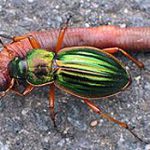Ground beetles are a large, cosmopolitan family of beetles, Carabidae, with more than 40,000 species worldwide, approximately 2,000 of which are found in North America and 2,700 in Europe.
Common habitats are under the bark of trees, under logs, or among rocks or sand by the edge of ponds and rivers. Most species are carnivorous and actively hunt for any invertebrate prey they can overpower. Some will run swiftly to catch their prey; tiger beetles (Cicindelinae) can sustain speeds of 8 km/h (5 mph) – in relation to their body length they are among the very fastest land animals on Earth. Unlike most Carabidae which are nocturnal, the tiger beetles are active diurnal hunters and often brightly coloured; they have large eyes and hunt by sight. Ground beetles of the species Promecognathus laevissimus are specialised predators of the cyanide millipede Harpaphe haydeniana, countering the hydrogen cyanide which makes these millipedes poisonous to most carnivores.
As predators of invertebrates, including many pests, most ground beetles are considered beneficial organisms. The caterpillar hunters (Calosoma) are famous for their habit of devouring insect larvae and pupae in quantity, eagerly feeding on tussock moth (Lymantriidae) caterpillars, processionary caterpillars (Thaumetopoeidae) and woolly worms (Arctiidae), which due to their urticating hairs are avoided by most insectivores. Large numbers of the Forest Caterpillar Hunter (C. sycophanta), native to Europe, were shipped to New England for biological control of the Gypsy Moth (Lymantria dispar) as early as 1905.
A few species are nuisance pests. Zabrus is one of the few herbivorous ground beetle genera, and on rare occasions Zabrus tenebrioides for example occurs abundantly enough to cause some damage to grain crops. Large species, usually Carabinae, can become a nuisance if present in numbers, particularly during outdoor activities such as camping; they will void their defensive secretions when threatened, and if they hide among provisions this can despoil food. Since ground beetles are generally reluctant or even unable to fly, it is usually easy to block their potential routes of entry mechanically or with a topical insecticide.

